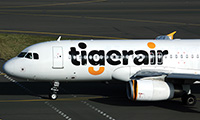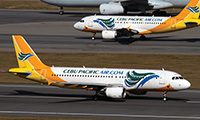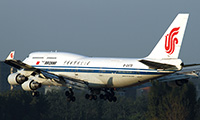Main Story
GLOSS GOES OFF MARKET
Asia-Pacific airlines continue to grow traffic at an impressive rate, but for many of them profits are declining as increased competition, rising costs and a capacity imbalance erode yields. Is it cyclical or a longer term problem for the region’s carriers?
September 1st 2014
When the International Air Transport Association (IATA) issued its latest global profit forecast at the annual general meeting in Doha in June, Asia-Pacific carriers were predicted to report a collective 2014 profit of US$3.2 billion, compared with a $2 billion profit a year earlier. Read More »
The next IATA forecast will be in December and there are signs the results of the region’s carriers will fall way short of that figure.
 |
With a few notable exceptions, operators are experiencing the toughest market conditions in years. Their accounts are being attacked by stubbornly high fuel costs, exchange rate distortions, sustained competition from, and between, budget carriers and a continuing capacity imbalance that is sending yields downwards.
The results of two airlines alone, Qantas Airways and Malaysia Airlines (MAS), could wipe out most of the potential combined profits of the region’s industry.
Qantas Airways last month reported the biggest ever loss in the history of Australian aviation, a net deficit of US$2.6 billion in its year ended June 30, more than double market expectations. The carrier was hit by a record fuel bill of $4.2 billion, $236.3 million more than the previous year. It also took a $2.4 billion hit from a write-down, due to a company restructure that includes a re-valuation of its fleet. The carrier also suffered from a strong Australian dollar, increasing international competition and a domestic price war with rival, Virgin Australia. Losses at its international arm worsened, rising from $229.7 million in the 2013 year to $464.1 million in the latest twelve months, However, currently in the midst of a $1.87 billion transformation program, Qantas chief executive, Alan Joyce said the worst was now over and forecast the carrier is expected to return to underlying profit growth in the first half of the current financial year.
MAS, for obvious reasons, has seen an already parlous financial position deteriorate further as it struggles to recover from the impact of two tragic air accidents within five months at the carrier.
But they are not alone. Across the region, most airlines are struggling to report decent profits. This fragile fiscal picture has emerged as the region continues to dominate world aviation growth statistics. Last year, Asia-Pacific airlines carried 1.012 billion passengers, the largest number of air travelers of any region in the world. The 9.3% year-on-year increase was well ahead of Europe (825.9 million passengers and up 3.4% over 2012) and North America (818.9 million or a 0.7% rise over 2012).
Chinese passengers numbered 404.2 million, an increase of 11.8% on the previous 12 months. Two of the world’s top three city-pairs, based on international passengers, were Hong Kong-Taipei (4.9 million, but down 11.5%) and Jakarta-Singapore (3.4 million, an 8.6% increase). The top three city-pairs, based on passengers carried on domestic routes were Jeju-Seoul (9.58 million, up 1.4% over 2012), Sapporo-Tokyo (9.17 million, up 4.7%) and Fukuoka-Tokyo (8.34 million, up 9.3%).
 |
| Tigerair to develop as a budget network carrier rather than a point to point operator |
Are the region’s carrier’s faring badly? IATA chief economist, Brian Pearce, told Orient Aviation that apart from specific local issues affecting travel demand, such as the MAS situation and Thailand’s political situation, there is little sign of any immediate problem with the Asia-Pacific’s main travel markets.
“Markets to Europe, North America, the Middle East and within Asia all reported quite robust growth in the April to June quarter. Cargo is not strong, but is growing and Q2 looks no worse than Q1. Economic data appears OK, with emerging Asia industrial production continuing at around 7% per annum and business confidence is rising a bit, though Japan is weaker after the tax rise. Travelers and shippers are mostly moving in the right direction.”
But capacity, or too much of it, is an issue. Pearce pointed out that revenue passenger kilometres (RPKs) carried by Asia-Pacific airlines have slowed in recent months and now are growing no faster than the global average, whereas they had been expanding faster by two to three percentage points.
“So it looks as though there has been some loss of share in some markets for those airlines. At the same time, capacity has not slowed in line with traffic carried. Asia-Pacific capacity is still expanding around 2 percentage points faster than the global average,” Pearce said.
“Passenger load factors have drifted downwards recently. Financial reports show passenger yields also have weakened with competition from the additional capacity, both within the region and from outside airlines. It looks as though this and the local issues have been the source of the second quarter decline in financial performance.”
The question is whether this is temporary or not, Pearce said. “Regional economies have certainly slowed from the strength of earlier years, but still look to be steady and, on average, in good shape which points to a rebound.
 |
| Budget carrier, Cebu Pacific holds more than 60% of the domestic market in the Philippines |
“Cargo has been the main problem for the Asia-Pacific, but it seems to be slowly on the mend, which would also point to a rebound. Competition on long-haul markets connected to the region has certainly intensified and that looks like a structural challenge to Asia-Pacific airlines, but I can’t see that as a reason for a Q2 deterioration.
“We should remember financial data is volatile, due to various accounting adjustments and timing issues. What you are seeing may well include a significant amount of noise plus specific local factors, rather than being a change in trend.”
The latest figures from the Association of Asia Pacific Airlines (AAPA) showed continued expansion of international passenger and air freight markets in June, but at a slowing rate. International passengers were 20.6 million, 2.1% higher than the same month last year. But compared with previous months, June traffic growth was relatively slower, with leisure travel demand still partly affected by the political situation in Thailand.
Demand grew by 2.5%, whilst available seat capacity increased by 5.3%, resulting in a 2.1 percentage point fall in the average international passenger load factor, to 77.7%, for the month. AAPA director general, Andrew Herdman, said the first six months of this year saw a 4.9% increase of international passengers carried by the region’s airlines, to an aggregate total of 123.5 million. Within the same period, air freight demand grew by 4.6%, underpinned by a long awaited pick-up in global trade activities.
“The overall traffic demand environment in the region is still expected to be positive, supported by continued growth in regional economies and further improvement in the U.S. and European economies. However, competitive pressures remain intense, forcing Asia-Pacific airlines to maintain a close watch on costs while carefully managing capacity,” Herdman said.
 |
| Foreign exchange losses largely responsible for 58% decline in interim profits at the Mainland flag carrier |
But the financial landscape looks bleak in a number of markets. Qantas saw a deterioration in the financial performance of its Asian Jetstar budget subsidiaries which when combined lost some $65.4 million this year, almost $19 million worse than a year earlier. This included start-up costs associated with Jetstar Japan and a $40 million deficit at Jetstar Asia in Singapore, which Joyce said was a consequence of significant capacity being added in the market. “That has resulted in all carriers in Southeast Asia losing money. Tigerair’s losses were significant. AirAsia X, I think had significant losses. But we are seeing an alleviation of that capacity situation. I would point out that Jetstar Singapore had been profitable for the four years prior to this year. Going forward, we are optimistic with capacity rationalizing,” said Joyce.
All of Thailand’s listed carriers have reported losses, after being badly stung by nine months of political unrest. Ailing national flag carrier, Thai Airways International (THAI), was the biggest loser, with a deficit of $239.8 million for the April-June period (it lost $375.7 million for the full year in 2013). Budget carriers, Nok Air and Thai AirAsia, posted losses of $5 million and $5.5 million, respectively. Apart from the social unrest, they all blame fierce competition among full-service and discount airlines for the downturn. THAI’s second quarter result raised its combined losses for the first half of the year to $322.5 million.
In China, the depreciation of the yuan this year against the US$ has affected all Mainland airlines as most of their debt is US dollar-dominated. China’s big three state-owned airlines – Air China, China Southern Airlines and China Eastern Airlines – have cited foreign exchange losses as the main cause of their declining performances. China Eastern will book a first-half profit of less than US$8 million, compared with a $94.7 million profit for the same period a year ago.
Beijing-based Air China said foreign exchange losses were responsible for its 58% drop in interim profit, to US$76.94 million, following a 2.5% decline in the Mainland’s currency in the six months to June 30. At press time, China Southern was forecast to incur losses of up to $178 million in the first six months of this year, compared with a $49.1 million profit last year.
Continued poor performance among India’s hard pressed airlines, weighed down by high taxes, fierce competition and discounting is an additional drag on the region’s financial results although analysts believe India’s carriers are about to experience a sustained upturn as the country’s economy improves under the new government.
 |
| 'The recent decline in profits may well be a significant amount of noise plus specific local factors, rather than a change in trend' |
| Brian Pearce Chief economist IATA |
Even Singapore Airlines (SIA) is feeling the pinch. It reported a 52% fall in its first-quarter operating profit as intense competition for passengers and cargo squeezed yields at Asia’s second-biggest airline. “Aggressive fares and capacity injections from competitors will continue to place pressure on yields”, the airline said in a statement accompanying its latest results announcement.
Battling intense competition from Gulf and discount carriers, SIA chief executive, Goh Choon Phong, is pushing Singapore’s premium airline into new markets, including India, while increasing the group’s exposure to the low-cost market through its fully-owned subsidiary, Scoot, and affiliate Tigerair.
SIA reported an operating profit of $31.8 million in the quarter ended June 30, compared with a $65.4 million profit a year ago. “Looking at the competition and what is coming in terms of capacity, the next one to two years will continue to exert pressure on yields. We will have to manage our costs better, including fuel costs, in order to stay competitive,” said the carrier’s chairman, Stephen Lee. Over-capacity in the cargo market is hitting SIA, whose cargo unit reported an operating loss.
Another carrier with bottom line problems is Garuda Indonesia, which reported a $212 million interim loss to June 30, a figure almost twenty times greater than the $10.92 million loss in the same period last year. It has cancelled plans to launch two international routes, from Jakarta to Manila and Mumbai, respectively and delayed aircraft deliveries. Its situation won’t be helped by the resignation of its experienced president, Emirsyah Satar, by year end. Under Indonesian legislation, heads of state-owned enterprises can only serve two four-year terms in the job. Satar’s time will be up in October.
Japan Airlines (JAL) saw its group net profit for the April to June fall 19.4%, from a year earlier, to $143.2 million. The carrier attributed the fall off to higher fuel prices and maintenance expenses for its aircraft. JAL’s group operating profit dropped 15.6%, to $180.4 million, on consolidated revenue of $3.1 billion, a 4.4% increase driven by increased international travel demand.
Rival All Nippon Airways (ANA) returned to the black in the June quarter, but only just. It posted a $3 million operating profit for the three months, on a 10% rise in revenue, largely attributable to its expanded quota of international flights at Tokyo’s Haneda Airport, compared with JAL, and higher fuel costs.
Taiwan’s China Airlines (CAL) and EVA Airways both reported quarterly losses to March 30, with CAL recording a widened deficit of $91 million, against a net loss of $37 million a year ago. The CAL results were its worst losses since the third quarter of 2009. Weaker air cargo business continued to drag down the flag carrier’s financial performance. EVA saw quarterly losses improve slightly during the January to March period, at $30.3 million, from $30.6 million a year ago.
A handful of the region’s carriers saw their bottom lines improve. Korean Air (KAL) swung to profit in the second quarter. A strong won, its local currency, reduced the value of KAL’s foreign debt and the price of imported jet fuel, while encouraging more Koreans to travel abroad as they had more won to spend. It reported a net profit of $337 million in the April-June period, a massive turnaround from a net loss of $352 million a year earlier. “In addition to the won’s gains, the passenger traffic expansion on our China routes more than offset the weak Japan routes and contributed to the decent second-quarter performance,” a company statement said.
KAL booked $464.5 million in foreign debt-related conversion gains in the second quarter, after the won gained more than 8% against the U.S. dollar, a six-year high.
In Hong Kong, Cathay Pacific Airways announced a $45 million first-half profit, compared with a $3.1 million profit a year earlier. The airline reported a fuel hedging gain of more than $130 million for the six months, although its overall fuel costs still rose as consumption increased 6%.
“Managing risk associated with high and volatile fuel prices remains a priority,” said Cathay chairman, John Slosar. “Our fuel hedging extends to 2017. We have taken advantage of downward movements in fuel prices to take up new positions. “The operating environment for the Cathay Pacific Group - and the aviation industry as a whole - remains challenging,” said Slosar. “We face significant competition in our passenger business. This makes it difficult to maintain yields. The air cargo business remains problematic because of excess capacity. Intense competition similarly puts pressure on yield.”
In most cases, budget airlines are doing far better than their full-service counterparts. In the Philippines, Cebu Pacific, which holds more than 60% of the domestic market, has reported a record net profit of $68 million for the second quarter of the year, an impressive achievement given profits of nearly every other airline in Southeast Asia slipped during the three months.
Cebu has been helped by consolidation in the Philippines domestic market, with competitors cutting capacity. As a result, Cebu has achieved a double digit improvement in yield and has benefitted by a return to rational pricing in the domestic market, after an extended unsustainable discount war between carriers.
Malaysia’s AirAsia saw its net profit in the June quarter increase five-fold to $116 million, boosted by foreign exchange gains, deferment of taxes and a small increase in the number of passengers. Operating profit, however, declined 17%, burdened by losses at affiliate, Thai AirAsia.
AirAsia is expected to benefit from MAS’s restructuring, which includes trimming routes and capacity. MAS and the AirAsia group have added capacity in the last two years. The recent entry of Malindo Air, a subsidiary of Indonesia’s Lion Group, into the market is increasing pressure on all Malaysian operators.
AirAsia group chief executive, Tony Fernandes, said it was encouraging that average air fares in Malaysia declined by only 1% year-on-year in the three months to June 30, compared with a 9% decline in the previous quarter. “We are beginning to see some rational competition, which will only improve, and quite dramatically, after MAS’s privatization. I suspect capacity will be taken out,” he said.
It’s not all good news in the budget sector. Singapore-based Tigerair, part-owned by SIA, continues to struggle. Its losses widened to $53 million in the quarter ended June 30, from $26.3 million a year earlier, mainly due to costs incurred from the closure of its Indonesia and Australian operations.
Chief executive, Lee Lik Hsin, who took charge in May said: “We want to increase the overseas revenue contribution to our revenue base. We need to market ourselves more like a network carrier instead of a point-to-point carrier. In order to grow, and grow profitably, we need to expand beyond that,” he said. Tigerair has grounded planes, canceled aircraft orders and exited overseas joint ventures as it restructures following three straight annual losses. In its year ended June 30, it reported a pre-tax loss of nearly $270 million.